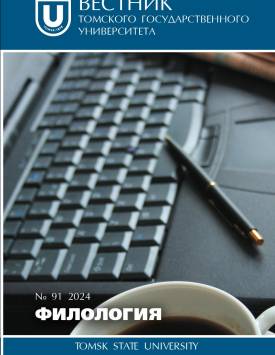Zoomorphic code of Vologda dialects: A derivational aspect
The necessity to study the derivational potential of the word in Russian territorial dialects determines the relevance of the research. The authors of the work focus on the animalistic vocabulary from Vologda dialects reflected in the published editions and the card index of the Vologda dialects dictionary. This animalistic vocabulary contains more than 850 names, with more than 300 names of pets, about 150 names of wild mammals, more than 100 names of birds as well as names of birds, fish, insects etc. We comment on the inner form of animal names, describe general language features of these words’ structure (predominance of Russian morphemes in their structure and formation of most of these words according to general language derivational models) and their local features: presence of dialect names, conservation of more archaic distribution and general language word semantics in the analyzed words, different derivational potential of all-Russian words in the standard language and the analyzed dialects. We analyze the lexical structure and derivational relations in dialect derivational word-families either formed from names of animals or including them as derivative words. We make conclusions about the specificity of modern Vologda dialects’ “zoomorphic code” based on this information and results of content analysis of statements about animals received in expeditionary observations of the speech of villagers from Vologda Oblast. This work proves that verbalization of “animal world” in Vologda dialects is a system of one-word and composite nominations, their inner form and contextual environment represent typological properties of the dialect linguistic view of the world: priority of human biological survival in harsh environmental conditions and its social adaptation in peasant community, traditionalism and expressiveness. The “animal world” in its objective, axiological and actional components is a part of the dialect linguistic view of the world, including features of inanimate nature, flora, and the human world. The “zoomorphic code” of the analyzed dialects finds its manifestation in an inseparable connection between the “animal world” and the “human world”, which is reflected in the parallel wording of the most important physiological processes (conception, pregnancy, birth of offspring; caring for children and animals; illness and death) as well as in the realization of typical schemes of the semantic transfers linking events of the “human world” and the “animal world” in a single semiotic unit. The authors declare no conflicts of interests.
Keywords
Russian dialectology, dialect lexicography, morphemic and word-formation structure of words, dialects of Vologda OblastAuthors
| Name | Organization | |
| Ilyna Elena N. | Vologda State University | filfak@list.ru |
| Ganitcheva Svetlana A. | Vologda State University | sganicheva@mail.ru |
References

Zoomorphic code of Vologda dialects: A derivational aspect | Vestnik Tomskogo gosudarstvennogo universiteta. Filologiya – Tomsk State University Journal of Philology. 2024. № 91. DOI: 10.17223/19986645/91/4
